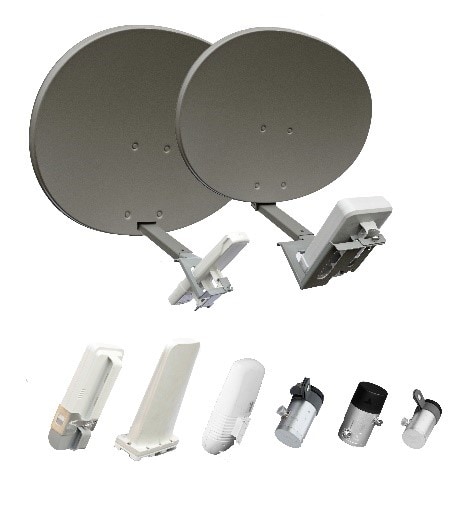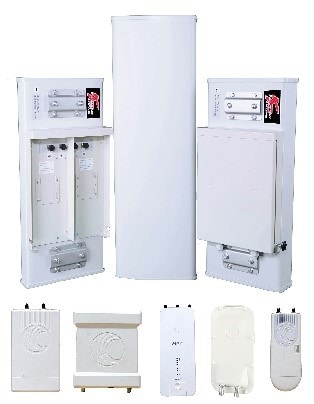WISPs Bring High-Speed Internet Access to the Hinterlands
In urban areas, cable and fiber technologies compete fiercely for customers’ broadband, phone, and entertainment services. Broadband download speeds greater than 100Mbs are available along with more channels than any single person could take advantage of. So, it’s easy to forget that for millions of people, these choices simply aren’t available at any cost, and in some rural areas, dial-up and possibly DSL are the only options for broadband. One solution to providing Internet connectivity in rural areas is Wireless Internet Service Providers (WISPs), which serve an estimated four million people.
What Are WISPs?
A WISP is a fixed wireless access (FWA) or broadband wireless access (BWA) “last mile” service, meaning that it serves fixed locations rather than mobile devices, typically using a bidirectional point-to-multipoint approach. That is, a single location transmits to and receives from multiple locations. Although most are in rural areas, they can also be found in cities where they fill in coverage gaps or provide backup data service for businesses. WISPs range from very small companies with a few hundred subscribers to a few large companies with several hundred thousand.
As is true for all communication systems, operating frequency is a key determinant of how the system will be constructed and the performance it can attain. For example, lower frequencies below about 1GHz allow greater distances to be covered with less infrastructure, but because of dense spectrum usage only narrow bandwidths are available. At less-densely-populated higher frequencies, vastly greater bandwidth is available but much shorter distances can be covered, requiring more infrastructure.
Although WISPs have much fewer resources than huge telecommunications and cable companies, they have similar challenges in serving the greatest number of users with the least amount of infrastructure. In addition, it’s essential for them to use spectrum in the most efficient possible way by employing advanced coding streams and most recently MIMO and wireless access methods such as LTE. A few of the largest WISPs are also reportedly exploring the use of licensed spectrum in the areas they serve. The use of license spectrum has the advantage of sole frequency “ownership” and a legal means of enforcing it, but its enormous cost places it beyond the reach of all but the largest WISPs.
How They Do It
As they did in the early years of the industry, WISPs today deploy their services by bringing a fiber connection to the center of their service area where the tower is located, or as frequently is the case, cable or some other high-speed wired medium. After this is accomplished, the company begins to expand its coverage area by using point-to-point microwave links or fiber that connect to other primary base stations located on towers or other high structures. The customer premise equipment (CPE) consists of a small, high-gain dish-type antenna similar in size to those used for satellite television, which is pointed toward the nearest base station (Figure 1).

Figure 1: Typical customer reflector antenna (top) and the radios and feedhorns it supports. (Source: KP Performance Antennas)
WISPs employ several approaches to reach their customers, the most basic and least expensive of which is an omnidirectional antenna at the base station that provides 360° coverage. A sectored approach splits this into three or four groups that target only the company’s service areas or complete 360° coverage if required. A sectored approach requires more infrastructure and increases the cost to lease space on towers or other structures unless the WISP owns them (Figure 2):

Figure 1: A sector antenna system incorporating the radios (below) used at tower sites. (Source: KP Performance Antennas)
However, it makes more of a system’s bandwidth available to each user. Combined with coding schemes that pack more data into a stream and the use of MIMO, the sectored architecture also allows a WISP to scale its service with increases in subscribers without negatively affecting performance. MIMO lets each base station radio simultaneously serve multiple subscribers and performance per user increases in direct proportion to the level of MIMO. Most Installations today that employ it are of the 2 × 2 (two transmit and two receive antennas) variety, but the industry is moving toward 4 × 4, 8 × 8, and soon 16 × 16 MIMO solutions.
To understand this, consider a system that has 100 customers in a specific sector and 30MHz of total available channel bandwidth. A radio with 4 × 4 MIMO capability splits these customers into four groups of 25. As each group can avail itself of the full 30MHz of bandwidth, and bandwidth (and other factors) determines achievable throughput, data rates to each group can be higher. Without a sectored approach and MIMO, all 100 subscribers would split the 30MHz bandwidth and each one would have less.
The radios employed by WISPs are very sophisticated devices that belie their small size, typically not much larger than a book. A good example is Mimosa’s A5c that can use both Wi-Fi and TDMA, dynamically allocates time slots, accommodates upward scaling and optimizes frequency reuse with integrated GPS synchronization. It can achieve data rates up to 1.5Gbs to the user and can serve up to 100 subscribers using channel bandwidths from 20 to 80MHz in the 5GHz band. The radio incorporates Gigabit Ethernet, Multi-User MIMO, network processing functions, and dynamic spectrum management to reduce interference and optimize channel reuse.
The Road Ahead
When compared to their regulated counterparts, WISPs have few restraints other than maximum RF output power as they rely on unlicensed spectrum, but without regulation their future to some degree relies on the ability to make the best use of any available spectrum. This means that once a lower, more desirable frequency becomes saturated, they have no choice but to use higher frequencies that require more infrastructure to serve their customers.
The WISP concept is not unique to the U.S. and Canada as there are thousands of these companies throughout the world where the ability to quickly and cost-effectively provide Internet access has proven invaluable. For example, the One Laptop per Child initiative, whose goal is to boost education for the world’s children by distributing low-cost computers and Internet access, relies almost exclusively on fixed wireless access.
Like wireless carriers, WISPs are always searching for more spectrum. As frequencies become available resulting from new FCC allocations or some other spectrum realignment, WISPs fight to be included in the mix of services that can operate there. For example, the Citizen Broadband Radio Service (CBRS) created by the FCC opens up commercial frequencies between 3550 and 3700MHz for commercial services that must be shared with military radars and fixed satellite stations. However, the WISP industry is far from the only entity proposing to operate in this region, and its comparatively low-budget appearance gives it less clout than competitors that are better endowed.
To fight for them, WISPs have the Wireless Internet Service Providers Association (WISPA) in the U.S. and similar advocacy organizations in Canada and other countries. WISPA has more than 800 members that include WISPs, electric and telephone cooperatives providing Internet access, and equipment manufacturers. The organization works to encourage Congress in the FCC to write laws that support the industry, offer technical forums, and generally promote communication and cooperation between WISPs.
From a technology perspective, the continued growth of the WISP industry will rely on the availability of spectrum, spectrally-efficient coding schemes, MIMO, and advances in and reduced cost of signal processing hardware. The industry has already begun to employ many technologies that allow it to expand coverage while simultaneously increasing performance.
One of the most recent is the use of small base stations (small cells) that the industry refers to as “micro pops,” which bring base stations closer to the user, reduces latency (important for voice service) and optimizes the data rates that can be achieved. These micro pops did not require attachment to a tower but can be placed on almost any structure that is high enough and free of obstructions.
A typical WISP can offer data rates of at least 10Mbs along with VOIP telephone service up to 15 miles from each radio, and some include packages of satellite-delivered entertainment channels. The latter is likely to be less appealing in the future as WISPs increase throughput that will allow users to rely exclusively on broadband for accessing entertainment using streaming services such as Netflix, Hulu, and Amazon.
Conclusion
WISPs are likely to survive in today’s competitive telecommunications market even though they operate without the benefit of subsidies, exclusive licensing, or reliance on major telephone and cable companies. This is because fixed wireless access remains the least expensive way to deliver broadband data and voice service, even with population densities of only a few subscribers per square mile. They can also be a vital part of the rural communities they serve, providing emergency alert services as well as those dedicated to business. But no matter how large they become, WISPs will probably remain in the shadows as other wireless services takes center stage.